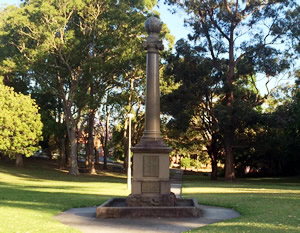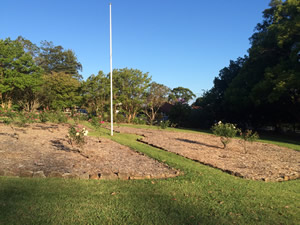Geography Stage 1
Overview

Cenotaph, Forest Park, Epping NSW, 2014
Students visit a war memorial in the local area, record its features and map its location and surrounds. Using sources and re-enactment students develop understandings of its significance. Students also use a variety of sources to investigate other uses of and arrangements of the site.
Teaching and learning activities

Memorial Garden, Forest Park, Epping, 2014
Question: What are the features of, and activities held at, the war memorial in our local area?
Researching
Nearly every town or suburb in Australia has a war memorial that honours those who served in wartime.
Visit a war memorial in your local area. This may be a cenotaph, memorial park, memorial gates, avenue or plaque. Visit the NSW war memorials register1.
Students observe and record the features of the memorial, its location, surrounding area and evidence of ways it is looked after.
Students create a pictorial map of the area.
View photographs of Anzac Day ceremonies held at the memorial to determine the activities and traditions that occur there, for example, dawn service, laying wreaths, bugle playing.
Re-enact part of an Anzac Day service on site.
Discuss other uses of the spaces at the site and how they are arranged when used for different purposes such as open air cinema events, carols in the park, sports presentations.
Processing
Locate the memorial on a map of the local area.
Label the memorial and activities held at the site on a map of the memorial’s immediate surroundings.
Create an annotated photo collage of Anzac Day ceremonies held at the memorial.
Create a table of the features of the memorial and the activities that occur at each, for example, cenotaph—laying wreaths, pathway—procession, rosemary in garden—for remembrance.
Communicating
Create a mock news report about the site which explains the features of the local memorial and the activities held there.
Learning concepts
These additional questions can be used for discussion or further investigations.
Challenge
What challenges are faced in maintaining or erecting memorials in local areas?
Change
Has the memorial and its use changed over time?
What features and activities have changed and what remain the same?
Caring
How is the local memorial and its surrounds cared for? Who is responsible for its care?
Community
How does the community use the local memorial?
Why do communities have local memorials?
Commemoration
What features of the memorial commemorate service personnel? What commemorative symbols are used?
Syllabus links
GE1-1 describes features of places and the connections people have with places
GE1-2 identifies ways in which people interact with and care for places
GE1-3 communicates geographical information and uses geographical tools for inquiry
Features of places
Students:
-
investigate features of places and how they can be cared for, for example: (ACHGK005)
– description of the natural and human features of places
– consideration of how a place can be cared for eg a park, farm, beach, bushland
How places are organised
Students:
-
investigate activities that occur within places, for example: (ACHGK007, ACHGK008)
– discussion of why and how the spaces within places can be rearranged for different purposes
Links
- http://www.warmemorialsregister.nsw.gov.au/